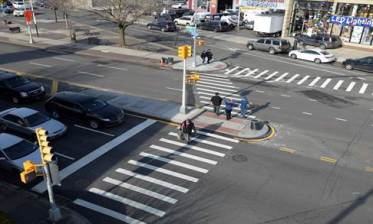On Queens Boulevard, de Blasio Lays Out 2016 Street Safety Agenda

Mayor Bill de Blasio outlined his 2016 street safety agenda to the City Hall press corps this morning, after DOT Commissioner Polly Trottenberg led a short walk by a redesigned section of Queens Boulevard. Police Commissioner Bill Bratton was a no-show for the second year running.
Noting that traffic deaths declined to a historic low in 2015, the mayor listed $115 million in capital projects to improve street safety on the docket for this year and said the city would push for legislation in Albany to lift restrictions on automated speed enforcement.
Last year, 231 people were killed in New York City traffic, according to preliminary figures in the city’s Vision Zero Year Two Report, which was also released today [PDF]. That’s down from 257 in 2014 and an improvement on the previous low of 249 fatalities in 2011. A citywide tally of severe traffic injuries in 2014 is just now available and also shows a significant improvement, declining about 12 percent from the previous year.
The most significant citywide change over the past two years has been the deployment of 140 speed cameras in combination with the lower default speed limit of 25 mph. State law, however, still limits the number of speed cameras NYC can deploy and restricts their use to areas near schools, during school activities. This means camera enforcement doesn’t happen at night, when speeding tends to be most prevalent.
It’s not clear exactly what the city will ask for in Albany, but de Blasio indicated that increasing the hours that speed cameras can operate is a high priority. The mayor said he hopes state electeds will put aside other political disagreements for the sake of safer streets.

Last year, City Hall’s list of Vision Zero projects included truly significant improvements to Queens Boulevard but also some projects that didn’t do much to change the status quo, like basic upgrades for Brooklyn’s Linden Boulevard.
The newly-announced $115 million for capital improvements also looks like a mixed bag, including several projects that were already known to be in the pipeline. It will go toward: $59.4 million in “Safe Routes for Schools” projects; $29.6 million to reconstruct and redesign streets in Long Island City; $4.1 million for the Brooklyn Waterfront Greenway; $22 million for capital projects on Tillary Street (presumably the Brooklyn Bridge Gateway project) and North Flatbush Avenue in Brooklyn; pedestrian plazas in Manhattan; and a redesign of Mott Avenue in Far Rockaway.
The city can redesign streets quicker with “operational” projects that don’t go through the convoluted capital construction pipeline. Most protected bike lanes, for instance, are implemented as “operational” projects. When asked if City Hall will increase funding for DOT’s operational projects, de Blasio said to hold tight for Thursday when his budget will be unveiled.
Some reporters harped on the perception that street safety projects slow down traffic and asked de Blasio and DOT Commissioner Polly Trottenberg about the resistance that street redesigns tend to meet.
“I think it’s really important to listen to the concerns of the community boards,” de Blasio said. “But let’s be very clear: we’re going to make the changes, we’re going to protect people’s lives, we’re going to put in the bike lanes — which are both good for bicyclists but also have a traffic-calming effect. There’s no question we’re doing it.”
“People have to think right about this,” he added. “It may be a little less convenient in their minds, but if they’re saving human life, I think it has to clearly be the priority. We have to do things a new way.”
This morning’s press event followed a tour of Queens Boulevard, where Trottenberg highlighted the Streetsie-winning redesign that added bike lanes, pedestrian space, and traffic calming treatments along 1.3 miles of the streets. Much more of the street needs to be redesigned, but last year was the first on record in which no pedestrians were killed on Queens Boulevard, Trottenberg said.
While the city has made progress the past few years, the pace of street redesigns will have to accelerate to sustain consistent reductions in traffic deaths year after year.
The mayor conceded that there is still much to be done. “Two years ago we said we would do everything in our power to prevent traffic fatalities,” he said. “There’s a lot more to do, no doubt, but this plan is working. We’re very proud of what’s happened, but it’s just the beginning.”
